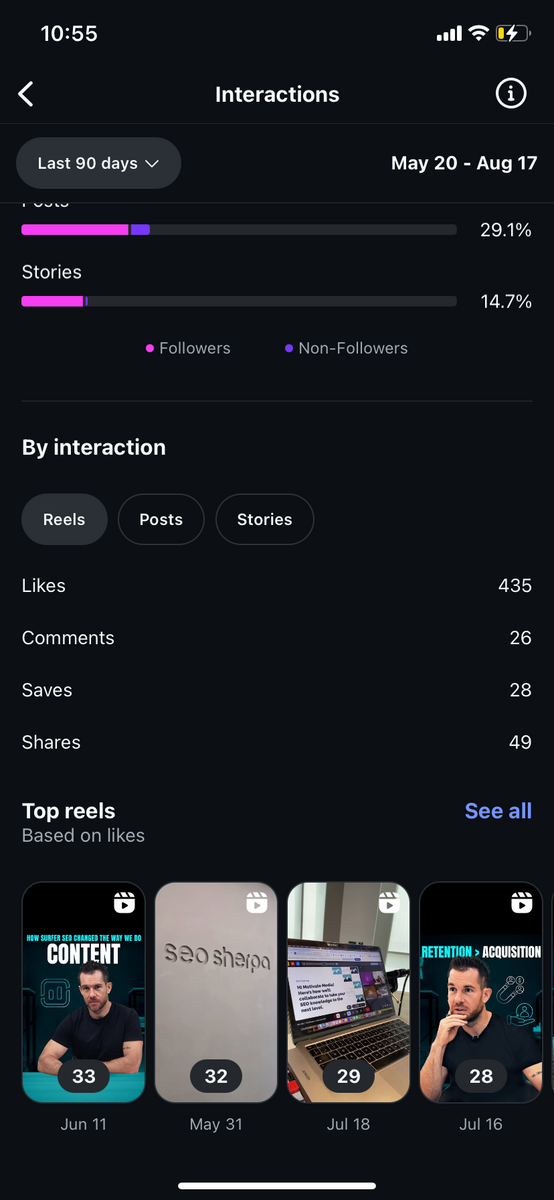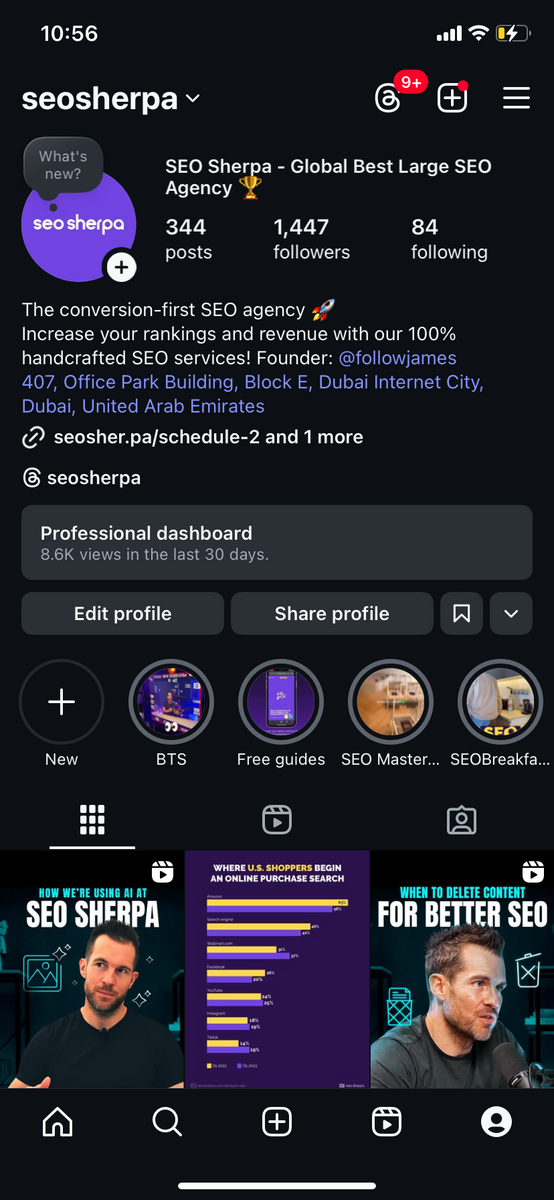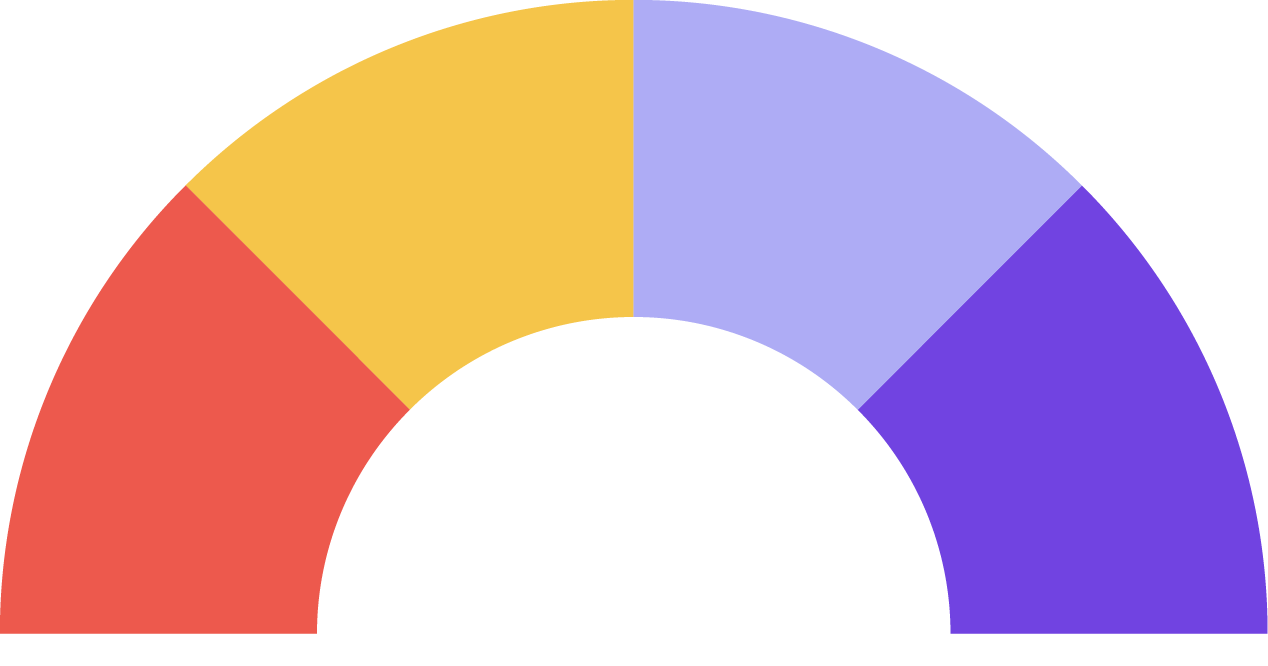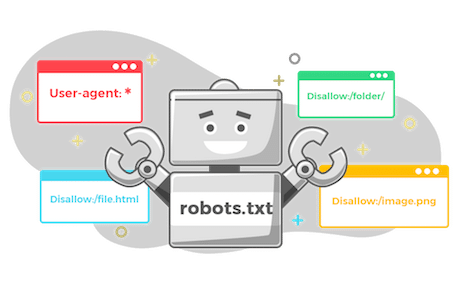
Instagram is no longer just a scrolling app. In 2025, it’s a full-blown search engine — and one that’s shaping user discovery in ways brands can’t afford to ignore.
With Meta doubling down on search functionality and both Google and Bing now indexing Instagram posts, the lines between social media and search engine results are blurring fast. Users aren’t just browsing for inspiration — they’re searching with intent. Whether it’s local businesses, product reviews, or expert advice, Instagram’s search bar has become the go-to shortcut for real-time, visual answers.
If you’re not showing up? Someone else is.
The shift is clear: Ranking on Instagram now requires the same SEO thinking you’d apply to Google — just with different signals. Instead of backlinks, you’ve got engagement. Instead of structured data, it’s about optimized captions, alt text, and hashtags. And instead of keyword stuffing, it’s about relevance, resonance, and reach.
In this guide, we’ll break down exactly how the Instagram algorithm pulls content into search results — and what your brand needs to do to get discovered in this new era of Social Search meets SEO.
Ready to optimize for the ‘Gram like it’s an SERP? Let’s go.
How does your website score? Get a free instant audit that will uncover the biggest SEO issues affecting your site, and how to fix them.
Article Summary
- Instagram Search is smarter than ever, and optimized content is discovered both inside the app and in Google.
- Ranking signals include profile relevance, engagement, and user activity, so focus on optimizing your bio, username, and content.
- Hashtags, captions, and alt text are still powerful, but only when used intentionally and strategically.
- Search and explore are not the same. Search is keyword-driven, and Explore is behavior-driven. Optimize for both differently.
- Instagram is now part of your Search Everywhere stack – what ranks here can appear in AI Overviews, Google, TikTok feeds, and more.
- Don’t sabotage yourself – ditch vague bios, hashtag spam, and ghosting your analytics.
How Instagram Search Works in 2025
Instagram’s search engine isn’t just “kind of” a search engine anymore. It’s acting more like Google every day. Instead of crawling pages and indexing keywords, it’s parsing captions, tags, alt text, and user behavior to decide what surfaces in the search bar.
Let’s break it down.
Instagram’s Search Mechanics: What’s Actually Happening?
When a user types something into Instagram’s search bar, say, “best curly hair products” or “brunch in Dubai” — the platform sifts through a massive index of:
- Public posts
- Professional accounts
- Reels and videos
- Location-tagged content
- Usernames, hashtags, and trending topics
And then? It ranks those based on a mix of algorithmic signals, all pointing to one thing: relevance.
According to Instagram’s own documentation (source), the top ranking factors include:
1. The Search Query Itself
Pretty basic. What the user actually types matters most. Instagram interprets this just like Google does, using semantic context and NLP to match against relevant content. That’s why using the right keywords in your username, bio, and captions is now non-negotiable.

2. User Activity
Instagram personalizes search based on a user’s past activity. Posts they’ve liked, accounts they follow, and even comments they’ve made. This makes engagement history a hidden ranking lever. If someone has interacted with your niche or content type before, you’ve got a better chance of appearing in their results.

3. Content Engagement
High-performing posts (likes, shares, saves, comments) are more likely to rank. But it’s not just about vanity metrics; the algorithm is sniffing out sustained, quality engagement over short-term hype. Think: useful Reels, thoughtful carousels, and comments that spark conversation.

4. Account Signals
Professional accounts with complete profiles, consistent posting, and a track record of helpful content tend to rank higher. Bonus points for accounts that are verified or tagged as a “creator” or “business.”
In short? Instagram search is driven by a mix of textual optimization, account quality, and real-time engagement. You’re not just optimizing for bots — you’re optimizing for how people use the platform and interact with content, and what the algorithm thinks they want next.


And if you want to appear in any of those searches?
You need to treat Instagram like a search engine — not just a social feed.
Why Instagram Search Matters for SEO in 2025
Let’s be blunt.
If you’re still thinking of Instagram as just a place to “build your aesthetic” or drop the occasional Reel, you’re missing the bigger picture.
Instagram is now a search engine, and more importantly, it’s part of the search everywhere ecosystem that’s reshaping how people find, evaluate, and choose brands.
Instagram as a Social Signal in Multimodal Search
Google isn’t just crawling blogs anymore. It’s pulling data from TikTok, YouTube, Reddit — and yes, Instagram. Posts, bios, comments, captions — all of it can send contextual relevance signals back to search engines and LLMs.
If your Instagram content uses relevant keywords, is linked across platforms, and earns engagement? That’s brand visibility that extends outside the app. Into AI Overviews, SGE results, and even ChatGPT-style answers.
Simply put: Instagram posts are now brand assets that feed the algorithmic beast.
Visibility in a Search Everywhere World
People don’t just Google you. They Instagram you. They TikTok you. They drop your name into Perplexity, or into the YouTube search bar to “see what you’re really like.”
That means every post you publish, every profile you optimize, and every hashtag you choose is part of your Search Everywhere Optimization stack.
Even more powerful? When your Instagram results appear directly on Google, which is already happening for many public profiles, especially those with optimized bios and tagged content. It’s a one-two punch of platform-native and off-platform visibility.
Real-World Use Cases: From Ghost Mode to Growth Mode
Here’s what this looks like in the wild:
- A traveler Googles “Things to do in Cairo,” sees a Reel on the SERP, and taps through to your Instagram.
- A shopper searches “best skincare for hyperpigmentation” and lands on your pinned post from six months ago — now trending again.
- A client checks out your name on ChatGPT and your brand is mentioned, but they click the IG handle to see the real you.
In all of these? Your visibility depends on whether you’re search-optimized across the funnel, not just ranking blog posts.
So if your SEO strategy isn’t touching Instagram?
It’s not just incomplete — it’s outdated.
Key Ranking Factors for Instagram Search
Instagram’s search isn’t just about who has the prettiest grid or the most followers. In 2025, it’s a signal-driven engine, and if you want to win visibility, you need to understand what makes content rank.
Here’s what actually matters — and how to make it work for you.
Profile Relevance Signals
It starts with the basics: your profile. Instagram pulls relevance cues from your bio, username, name field, and even your handle. If you’re a makeup artist in Atlanta, and your name is “Jane 💄,” but your handle is @glittergal444 — you’re missing a trick. Swap that for @makeupbyjaneatl and watch your discovery spike.
The algorithm reads your bio like a mini web page. It’s indexing for keywords like a search engine would. So if you’re a business, don’t waste that real estate on random emojis. Include relevant descriptors, services, and location. Bonus points for including your website and turning on the professional account setting — it gives you access to more analytics and visibility features.
Engagement Metrics
Just like traditional SEO, popularity and engagement are powerful signals.
But here’s the kicker: It’s not just about vanity metrics like likes or views. Instagram prioritizes saves, shares, comments, and profile taps — actions that show deeper intent.
This means you need content that starts conversations or solves real problems. Think: mini-tutorials, myth-busting posts, tips that make your audience stop and say, “Wait, I didn’t know that.” That’s the kind of content that gets saved and shared — and that’s what boosts your rank in search.
Want to really level up? Create content that drives DMs. Replies to Stories and question box interactions send strong engagement signals — especially since they happen in the private layer of the platform, where Instagram loves to track user satisfaction.
Activity & Behavior
Instagram wants active, consistent creators — not ghost town accounts.
The algorithm favors accounts that post regularly, respond to comments, engage with their followers, and act like a community member, not a megaphone.
That means if you’re only popping in once a month to post a Reel and dip, don’t expect to show up in search results. Instagram’s ranking factors include how often you post, how quickly you reply, and how much you interact with other content in your niche.
Even passive behaviors matter. What you watch, who you follow, and what you engage with tells the system who you are — and who should see your content.
In short: Instagram search is behavioral SEO. And the more your account behaves like a useful, consistent, relevant presence, the more likely you are to surface in the right places.
How to Optimize for Instagram Search
So you want to get discovered on Instagram? Great. But this isn’t 2017. You can’t just slap on a hashtag and expect the algorithm to do all the work. Optimizing for Instagram Search in 2025 means treating your content like searchable, crawlable mini-webpages, which starts before you even post.
Here’s how to give the algorithm everything it needs to push you higher in search results:
Optimize Your Profile and Username
First things first: If your username and name field don’t clearly describe what you do, you’re losing discoverability before anyone even hits the search bar.
The name field (not your handle) is the only searchable part of your profile bio. That means instead of “✨Sarah✨” you need something like “Bridal Hair | London Stylist.”
Keep your handle relevant, too — ideally using keywords your target audience would search for. Think @london.coffee.reviews instead of @coffeeislife44.
Then, your bio? Treat it like your homepage hero section. Mention what you do, who you do it for, where you’re based, and include a clear CTA. This builds both trust and algorithmic clarity.
Want extra credit? Enable a professional account to unlock analytics and more category-specific discoverability options (plus, it just looks more legit).
Hashtags, Captions, and Alt Text
Gone are the days of slapping 30 generic hashtags on your post and calling it strategy.
In 2025, Instagram reads everything — your captions, your image alt text, and even the text embedded in images or videos. So yes, Instagram sees that meme you’re posting. It also sees that infographic, that Reel overlay text, and your Stories captions. Use this power wisely.
- Hashtags: Use a focused mix of niche, industry, location, and branded tags. Forget #love and #instagood — try #capetownphotographer or #organicgardeningtips. Hashtags should act like searchable keywords, not decorations.
- Captions: Think long-form meets blog post. Lead with a hook, pack in the keywords naturally, and offer actual value. Captions aren’t just for storytelling anymore — they’re SEO real estate.
- Alt Text: You can manually set alt text when uploading photos — and you should. It boosts accessibility and gives Instagram more context to work with. Describe what’s in the image, include relevant keywords, and keep it natural.
Want tools? Try Flick or Display Purposes to find relevant hashtags, or ChatGPT (😉) to help draft alt text and captions with optimized keyword density.
Posting Strategy and Engagement
Consistency is queen. (And if you can’t be consistent, at least be useful, relevant, or hilarious.)
Instagram’s algorithm favors accounts that post regularly, but it also weighs how people interact with your posts. That means your content strategy has to do more than fill a grid — it has to drive action.
Here’s what works:
- Post at optimal times for your audience — and test them. You’re not just fighting the algorithm; you’re fighting for attention.
- Mix formats: carousels (great for dwell time), Reels (great for reach), and static posts (great for engagement if well optimized).
- Encourage engagement: Ask questions, use CTAs, reply to every comment, and respond to DMs. Instagram notices.
- Pin top-performing posts to your profile — especially ones that already rank for keywords or show high engagement.
Think of every post as an asset in your discoverability arsenal. Each one should be created with intention: a clear keyword theme, a message, and a measurable goal.
Remember, on Instagram, content is both your product and your SEO strategy.
Instagram Search vs. Explore Page: Where Does Your Content Actually Show Up?
You’ve optimized your posts. Nailed your hashtags. Even remembered to update your alt text (gold star for you). But then comes the classic Instagram curveball:
Are you showing up in Search or on the Explore Page? Does it matter?
The short answer is yes, it matters. A lot. These two features might live in the same tab, but they operate on completely different algorithms and serve very different user intents.
Let’s break it down.
What Triggers Each Feature?
- Instagram Search is user-initiated. Someone types in a keyword, hashtag, or account name, and Instagram tries to serve the most relevant results based on your input. It’s like Instagram’s mini search engine — and in 2025, it behaves more like Google than ever.
- Explore Page is discovery mode. Instagram shows you content you might like based on your past behavior: what you’ve liked, saved, commented on, watched, or even hovered over for longer than usual. No search required. It’s algorithmic guessing — and it’s getting scary good.
Algorithmic Differences
The Search algorithm focuses on:
- Keyword relevance (your profile name, bio, captions, alt text, and hashtags)
- Engagement on posts with those keywords
- Account credibility and recency of activity
Meanwhile, the Explore algorithm is powered by:
- Machine learning models trained on user behavior patterns
- Visual similarity (yes, it scans your images for themes/styles)
- Content you’ve engaged with recently — including type (e.g., Reels vs. posts)
So while Search is about intent matching, Explore is about behavior prediction.
You can optimize for both, but trying to game the Explore Page alone is like trying to flirt with someone from across the club via eye contact. They might look your way, but Search is the one who asked for your number.
Which Is Better for Organic Growth?
If you want consistent, qualified visibility. Search wins. Every. Time.
Search is high-intent. It connects you with users actively looking for what you offer: photographers in LA, vegan meal prep, crystal healing for ADHD, whatever your niche is.
Explore is passive. Sure, it can explode your reach, but it’s also more chaotic. One viral Reel might gain you followers who don’t care about your actual offer, or who never engage again.
The real MVP? Using both, strategically.
- Optimize for Search to be discoverable on your terms.
- Create scroll-stopping Reels and carousels to qualify for Explore.
And here’s the kicker: Content that performs well in Search often fuels Explore visibility later. So if you get the foundations right, Explore is just the cherry on top.
How Instagram Fits Into Search Everywhere Optimization
Instagram isn’t just a social platform anymore. It’s a search engine. It’s a Google data source. It’s a content hub for AI-generated answers.
And if you’re only optimizing Instagram to win on Instagram, you’re missing half the game.
Let’s break down why.
Instagram’s Role in Google’s AI Overviews and SGE
Here’s the reality: Google is treating social content — especially from platforms like Instagram, TikTok, and Reddit — as credible data for AI Overviews.
We’re already seeing:
- Instagram carousels cited in Google’s AI Overviews (with linked snippets)
- Reels and post pages ranking in organic results
- Instagram is being treated like a semi-indexed mini web
And yes, the big shift came in 2025 when Google started indexing Instagram post URLs, opening the floodgates for Instagram content to appear in search engine results pages (SERPs), AI Overviews, and voice search responses. Now, your caption might be read aloud by a Google Assistant. Think about that next time you’re writing hashtags.
Why Instagram Optimization Isn’t Just for Instagram Anymore
Your Instagram content now lives in a multi-modal, multi-platform discovery ecosystem. And that means:
- Your profile SEO impacts how often Google shows your page in branded searches
- Your caption language gets scraped and fed into LLMs (Large Language Models) like Bard or Gemini
- Your post URLs may be selected by Perplexity, Bing Copilot, or Google’s AI Overviews as evidence in a generative answer
- Your image alt text and visual content may impact how well you’re recognized in AI-powered visual search tools (including Google Lens and Pinterest Lens)
In short: Your content needs to be optimized not just for humans on Instagram, but for the machine readers crawling the web and aggregating information across platforms.
Connecting Instagram to the Bigger Ecosystem: TikTok, YouTube, Pinterest, and More
Think of Instagram as one node in your Search Everywhere Optimization strategy — not the end goal.
A single Reel might:
- Appear in the Instagram Search tab
- Get pushed to the Explore Page
- Be shared to Facebook (yep, that still happens)
- Show up in Google’s AI Overview when someone searches a related query
- Get picked up by a brand aggregator or media outlet (especially with a viral hook or branded hashtag)
Meanwhile, TikTok videos are being indexed more aggressively than ever. YouTube Shorts are ranking faster in SERPs. Pinterest Idea Pins are suddenly showing up in Bing Chat responses.
And Reddit comments are fueling half the product recommendations in AI answers.
This isn’t just search engine optimization anymore. It’s visibility optimization. Discovery strategy. Brand imprinting.
Instagram is your signal. Your proof point. Your citation-worthy content.
Bottom line?
Optimizing for Instagram Search helps your content:
- Get discovered on Instagram
- Get indexed on Google
- Get cited in AI Overviews
- Get noticed across every search-driven surface your audience touches
And that’s exactly what Search Everywhere Optimization is built for.
Common Mistakes to Avoid (and What to Do Instead)
Instagram Search isn’t the Wild West anymore. There are rules — and breaking them doesn’t make you clever, it just makes you invisible. Here are the most common ways brands shoot themselves in the algorithmic foot:
Overstuffing Hashtags
Just because you can use 30 hashtags doesn’t mean you should.
Flooding your captions with irrelevant or overly broad hashtags (#instagood #love #mood) doesn’t make your content more discoverable — it makes it look desperate.
Instead:
- Use specific, niche, and community-based hashtags
- Mix high-volume tags with lower-competition ones
- Place them in the caption, not a separate comment (yes, this matters for indexing)
Think of hashtags like seasoning — they should enhance the content, not smother it.
Incomplete Bios
If your bio just says “Founder | Dreamer | Coffee Addict ☕” and links to your Linktree… congrats, you’ve said absolutely nothing to help you rank.
Instagram bios are indexable. They matter for internal search on IG and external search on Google. An incomplete bio is a missed opportunity to:
- Add keyword-rich descriptors
- Reinforce your brand’s value prop
- Improve visibility for branded and category-level searches
Add your niche. Add your offer. Add a keyword or two. That’s the move.
Ignoring Audience Behavior
Instagram Search is increasingly personalized. What shows up in a user’s search results depends heavily on:
- Who they follow
- What they engage with
- What they’ve searched for recently
If you’re not paying attention to your audience’s behavior, you’re optimizing in a vacuum.
Spend time in the Explore tab. Search your own niche. See which posts are dominating — then reverse-engineer what they’re doing right.
Final Tips for Instagram Search Success
Let’s end with a few power plays:
- Optimize your post URLs. Since IG URLs are now indexed, make sure the first 100 characters of your captions are meaningful. This becomes the meta description in many SERPs.
- Create a visual hook. Use bold thumbnails for Reels and carousels that can stand out even when stripped of context.
- Use alt text intentionally. Don’t rely on Instagram’s auto-generated junk. Add descriptive, keyword-relevant alt text manually — this improves accessibility and your LLM visibility.
- Stay consistent. The algorithm (and your audience) loves routine. Train Instagram (and Google) to associate your account with a specific content category.
- Think platform-native, distribute platform-wide. Make content that works for Instagram first — but ensure it feeds into your Search Everywhere strategy.
Instagram Search isn’t just another social algorithm to game.
It’s your ticket to being discovered by humans and machines alike, whether they’re scrolling their feed, Googling your niche, or asking an AI assistant for recommendations.
Instagram Search Is No Longer Optional
In 2025, Instagram is more than a pretty photo grid — it’s a legitimate discovery engine. It powers results on Google. It feeds AI Overviews. It boosts your brand visibility across the digital ecosystem.
If you’re not optimizing your Instagram presence, you’re leaving search real estate on the table.
And here’s the thing:
The brands that win aren’t always the ones with the biggest ad budgets.
They’re the ones with clear, consistent messaging, searchable profiles, and a content strategy aligned to how people actually discover things today. Whether through keywords, visuals, or AI-powered suggestions.
Want help making sure your Instagram account shows up everywhere your audience is searching?
Book a free discovery call to learn how we can optimize your Instagram as part of our Search Everywhere Optimization service.
No fluff, no filters. Just smart strategy that gets you seen.











Leave a Reply